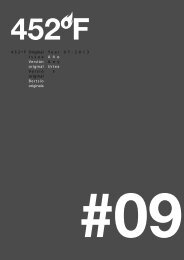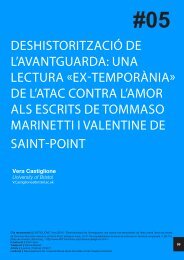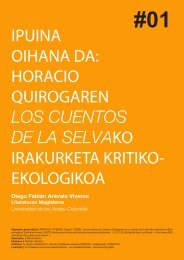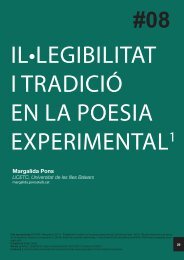03 - 452ºF
03 - 452ºF
03 - 452ºF
Create successful ePaper yourself
Turn your PDF publications into a flip-book with our unique Google optimized e-Paper software.
form for «simulated evacuation.» Jack later finds out that though the<br />
accident is real and the evacuation also is, this team is doing the<br />
real evacuation «in order to rehearse the simulation.» Using reality<br />
as a secondary testing for hyperreality means that hyperreality<br />
has the priority and that it is the new order of reality, i.e. more real<br />
than the reality we know. The real evacuation that is caused by the<br />
horrible «Airborne Toxic Event» is dealt with as a mere rehearsal for<br />
something more important, which is the simulated evacuation. What<br />
is more interesting is that this real evacuation seems chaotic and<br />
disorganized, whereas, later in the novel, when the team carries out<br />
the simulated evacuation, it looks organized and very orderly.<br />
The «SIMUVAC» team explains this process of simulation as the<br />
new rescue measure, through which future disasters would easily be<br />
prevented. It is simply the fear and the violence of the real that make<br />
people wish for simulations and hyperreality to take over their daily<br />
lives. One of the team technicians says, «The more we rehearse<br />
disaster, the faster we’ll be from the real thing» (DeLillo, 1985: 205).<br />
He also uses an example of people’s daily worries and suggests that<br />
simulating hyperreality would be the solution, «Life seems to work<br />
that way doesn’t it? You take your umbrella to the office seventeen<br />
straight days, not a drop of rain. The first day you leave it at home,<br />
record-breaking down pour.» (DeLillo, 1985: 205) Baudrillard in<br />
Simulations offers a detailed explanation of the process of simulation<br />
and how simulacrum is generated out of codes and models into the<br />
realm of hyperreality:<br />
Simulation is characterized by a precession of the model, of all models<br />
around the merest fact –the models come first, and their orbital (like the<br />
bomb) circulation constitutes the genuine magnetic field of events. Facts<br />
no longer have any trajectory of their own, they arise at the intersection<br />
of the models; a single fact may even by engendered by all the models<br />
at once. This anticipation, this precession, this short circuit (no more<br />
divergence of meaning, no more dialectic polarity, no more negative<br />
electricity or implosion of poles) is what each time allows for all the<br />
possible interpretations, even the most contradictory –all are true, in the<br />
sense that their truth is exchangeable, in the image of models from which<br />
they proceed in a generalized cycle. (Baudrillard, 1983: 32)<br />
The simulacrum is what people willingly want to believe; they rely on it<br />
to explain everything in their contemporary lives. In White Noise, the<br />
Gladneys refer to what is seen on TV or said on the radio to interpret<br />
the daily events. Heinrich refuses to trust his senses in observing the<br />
weather and chooses to believe the radio instead. He believes that<br />
all what is broadcast on the radio is true. Heinrich says:<br />
«It’s going to rain tonight.»<br />
«It’s raining now,» I said.<br />
«The radio said tonight.» (DeLillo, 1985: 22)<br />
Living in a simulacrum: how TV and the supermarket redefines reality in Don DeLillo’s White noise - Ahmad Ghashmari<br />
<strong>452ºF</strong>. #<strong>03</strong> (2010) 172-186.<br />
177










